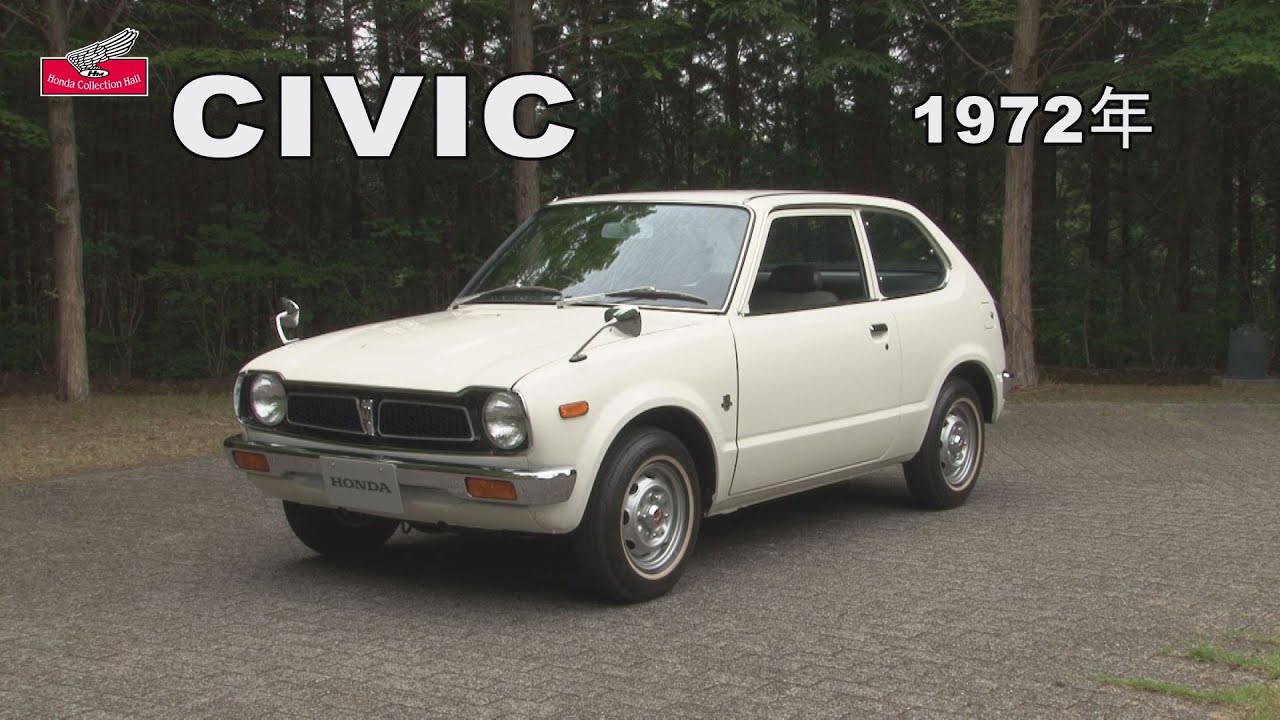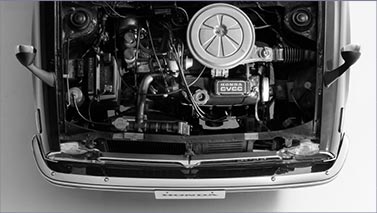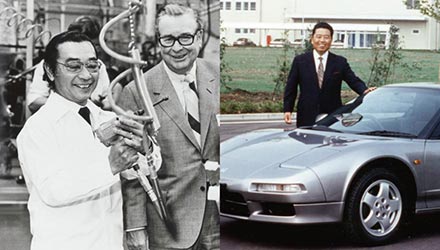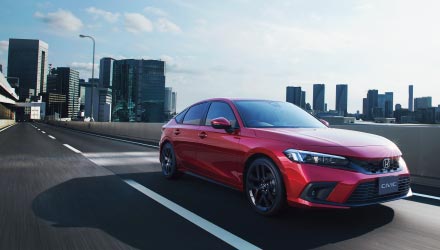The “Absolute Value”
As the development progressed, various targets were set, and the team members labored through a lengthy period of trial and error to attain the targets. First, the team comprehensively worked on weight reduction. The target for overall vehicle weight including a 1200 cc engine was set to be under 600 kg (approx. 1322 lbs.). Considering the fact that the Life k-car equipped with a 360 cc engine weighed 540 kg, and the 1300 equipped with a unique air-cooled 1300 cc engine weighed 875 kg, the 600 kg target seemed impossible to achieve.
The underlying motivation behind this pursuit of weight reduction was the idea that the cost of the vehicle would be proportional to the weight of the vehicle. It also made sense to focus on weight reduction from the standpoint of improving fuel economy. Learning from the methods used to minimize the weight of the Zero fighter plane the team tried everything, including reducing the thickness of the steel sheet in increments of 0.1 mm and modifying the structures of various elements of the vehicle.
Kume, the project’s first LPL, spent a lot of time himself in the warehouse with drawings and a weight scale by his side, evaluating every single component and telling the team members which parts needed to be lighter by how many grams and which parts were OK as they were. As a result of such thorough weight reduction efforts, the team successfully lowered the total vehicle weight to 680 kg (1,499 lbs.).
In the pursuit of “absolute value” for this new model, in addition to vehicle weight reduction, the team strived for a lightweight, high-rigidity and low-cost suspension system.
At the time, most FF cars were equipped with a rear suspension with a rigid axle design, in which the right and left wheels are connected laterally by a single axle (shaft). However, Mamoru Sakata, then in charge of suspension design, proposed using a strut-type, four-wheel independent suspension system which would allow independent control of the right and left wheels.
“We thought this suspension type would be the best match for the Civic,” Sakata explained. “Since we could broaden the interior space without an axle, we could achieve better handling and stability due to better front-rear weight distribution, and further reduce overall vehicle weight.” However, Soichiro Honda’s objection was easily predicted because Soichiro Honda favored a conventional rigid axle suspension the most because of its simpler structure and higher production efficiency. To avoid Soichiro Honda’s opposition, the team proceeded with the development of an independent strut-type suspension without consulting him.
One day, however, Soichiro Honda found out about the ongoing development of the strut-type suspension, and inevitably a meeting to discuss whether or not to go with the strut-type was set up on a different day.
Sakata had no intention of changing his belief that a strut suspension was the best match for the Civic. And Kume, who by then had handed over the LPL position to Kizawa and continued supporting the project as a supervisor, encouraged Sakata to “defend” his idea to go with a strut suspension. Feeling a heady mixture of confidence, pressure and anxiety, Sakata gingerly opened the door to the boardroom where Soichiro Honda and Kawashima, then Honda R&D president, were waiting.
Starting out timidly, but with all his heart and soul, he espoused the advantages of the independent strut suspension, and how essential it was to make the Civic a world-class car. However, even after sitting through Sakata’s earnest explanation, Soichiro Honda was not convinced and looked reluctant. “I just don’t see any merit in the independent suspension,” said Soichiro Honda, and asked Kawashima to weigh in with his opinion.
This was the moment Sakata heard pleasant words coming out of Kawashima’s mouth. Kawashima said, “He made such an enthusiastic argument. So, why don’t we let him try it out?” Realizing that Kawashima was convinced of the plan, Soichiro Honda’s simply said, “Alright, then, do it.”
Sakata’s firm conviction, which inspired Kawashima, resulted in the development of the independent strut-type suspension that Sakata and his team longed for.
Upon the completion of the development, the team took the Civic out for a drive throughout Europe and the U.S. and asked locals to drive as well, which enabled the team to realize they had achieved their goal of creating a world-class car. And the independent strut suspension became a vital technology adopted by many other small to mid-sized Japanese cars which followed Civic to market.
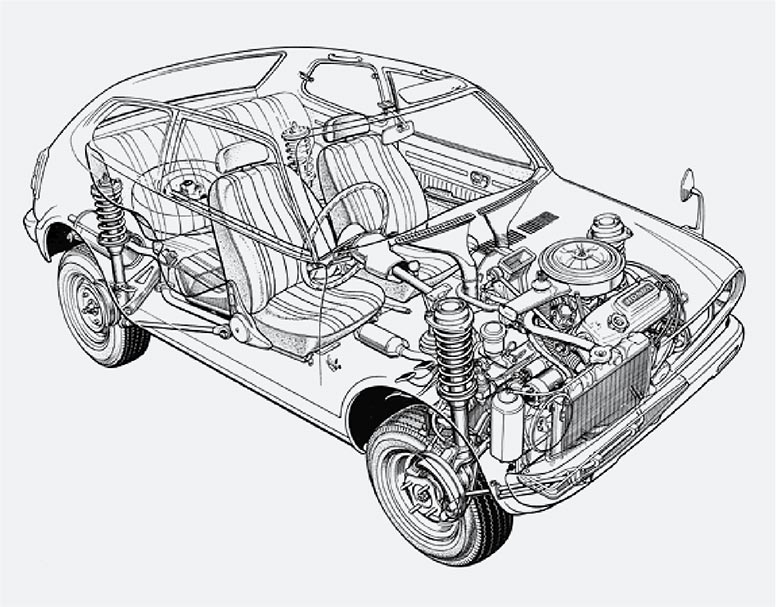 Perspective view of the first-generation Civic. The innovative trapezoidal body, compact transversely-mounted engine, and four-wheel independent strut suspension system, which was rare for FWD cars at the time, provided a spacious cabin.
Perspective view of the first-generation Civic. The innovative trapezoidal body, compact transversely-mounted engine, and four-wheel independent strut suspension system, which was rare for FWD cars at the time, provided a spacious cabin.
While retaining Honda’s racing spirit, the engine development for the Civic began with the goal of creating a practical liquid-cooled engine that would be a far cry from the DDAC (Duo Dyna Air Cooling) engine developed for the 1300, with its integrated double-walled cooling structure. The biggest challenge was to create an engine that would enable ample cabin space within the car’s limited size. The only way to achieve this was to mount the engine transversely and connect it directly to the transmission. Even with this layout, the initial calculation indicated that the length of the engine had to be reduced to the smallest of measures, otherwise, the steering wheel wouldn’t be able to fully turn.
To achieve this radical downsizing of the engine, the team devised every possible measure, including squeezing the water pump inside the engine block, as well as placing the oil pump inside the oil pan, driving it with a drive shaft connected to the center of the camshaft, and distributing the oil through the drive shaft, instead of adopting a typical oil pump driven directly by the crankshaft. Through all of these measures, engine length was shortened by 25 mm so that it fit into the Civic’s compact engine compartment.
Performance targets were set with a maximum output of 60 PS at 5,500 rpm and maximum torque of 9.5 kgf-m at 3,300 rpm. The team prepared detailed drawings for both 1100 cc and 1200 cc engines, but by the time of the market launch the company made the decision to focus on the 1200 cc (1,169 cm3) engine.
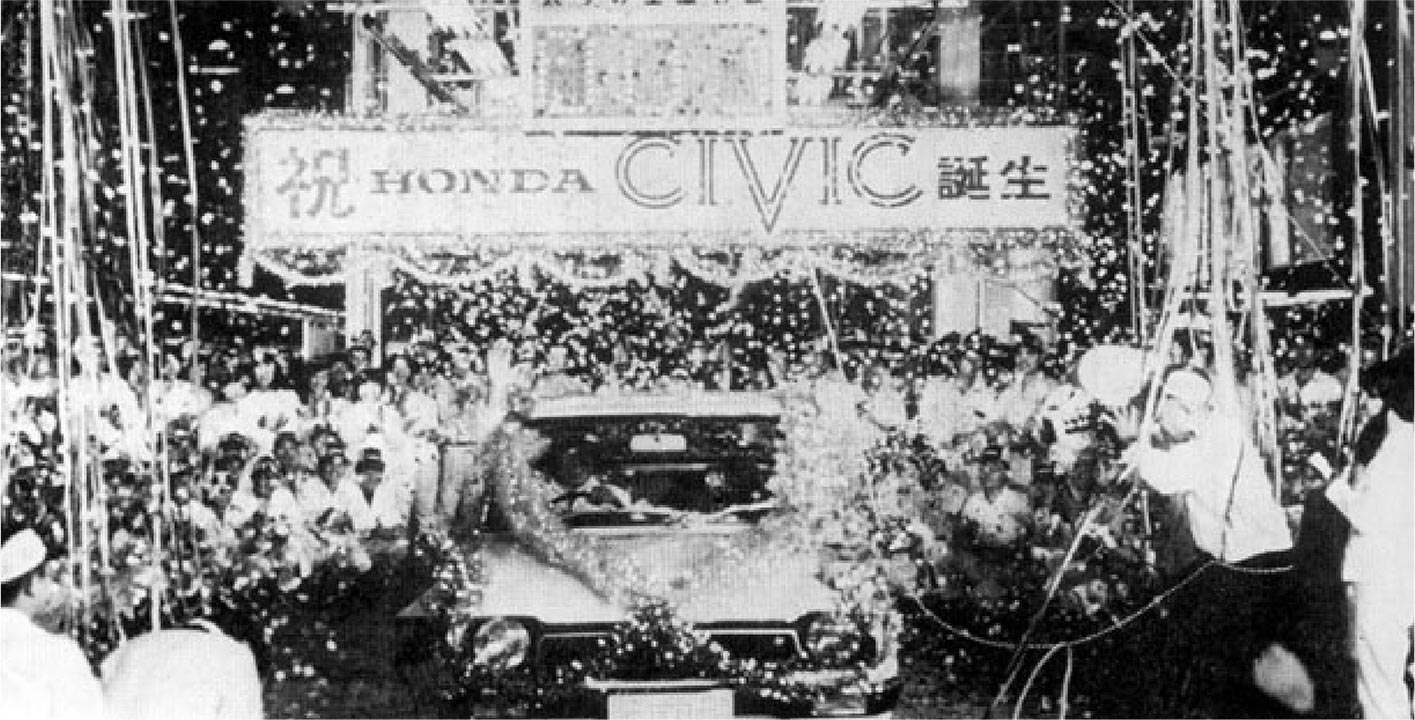
Civic line-off ceremony held in July 1972. Since then, the Civic created a new market, especially among the younger generation.
Cultivating New Markets
As expected, the Civic's styling received a cold stare within the company. Even the members of Honda R&D were skeptical about the likelihood that a car with such unique styling could sell well. When Civic was unveiled to the sales division, someone asked a question with a straight face regarding the description of “three-door”: “So, on which side of the vehicle is the third door located?” This indicates how little known the “three-door hatchback” styling was at the time.
However, the more the engineers tried to be faithful to the development concept, the more the “trapezoidal” three-door hatchback styling seemed ideal. So, Iwakura went around and explained the meaning of this styling, using various expressions to enhance people’s understanding, such as “The car is stable because of its trapezoidal geometry,” and “It isn’t like a delicate hand with slender fingers, but more like a firmly clenched fist.”
Such communication efforts worked, and Honda R&D members who had never seen the trapezoidal styling began to understand and accept it and, eventually, this design gained overwhelming support from industry experts and journalists who were familiar with trends in automobile markets outside Japan. Kizawa recalled: “Though it was a bit of an exaggeration, some critics were saying that if you didn’t understand the Civic, you didn’t understand cars at all.”
By the time the Civic was finally ready to go on sale, all development team members – who initially could only pray and hope for the car to sell – came to have a strong sense of confidence that Civic would sell. In fact, only two years had passed since they saw the shocking view of the sluggish production line at Suzuka Factory. In other words, the Civic hit the market after a development period of only two years, which was much shorter than the industry standard of that time. In 1972, the two-door version and the 3-door GL version were launched in Japan, in July and September, respectively.
“One day, Mr. Kume took me out for a dinner to celebrate the launch of the Civic,” Iwakura recalled. “Mr. Kume introduced me to the people at the restaurant by saying ‘He is the one who designed the Civic.’ They all knew Civic, but one person said, ‘Oh, I know. That is a cheap car, right? Because all high-end cars have a tail (trunk). The Toyota Crown is the best, followed by the Corona. The Publica still has a small trunk, but Civic has no trunk at all.’ To be honest, that comment gave me quite a shock.”
The initial reaction Civic received in the market was similar to what it initially experienced within Honda. People seemed puzzled by the “trapezoidal” styling which they had never seen before. As if representing this customer confusion, Civic sales experienced a sluggish start. However, as soon as the 3-door GL type went on sale, Civic’s popularity exploded, especially among younger people. In fact, it became such a big hit that monthly production soon climbed to more than 12,000 units.
Although first year (1972) unit sales was a modest 21,000 units – as a mere five months remained in the year when the first two-door type was launched – sales reached 80,000 units the following year, and topped 60,000 units for two consecutive years, in 1974 and 1975. Moreover, the Civic was named the Japan Car of the Year (organized by Motor Fun Magazine) in 1972, 1973 and 1974, becoming the first model in the history of the award to win the award for three consecutive years.
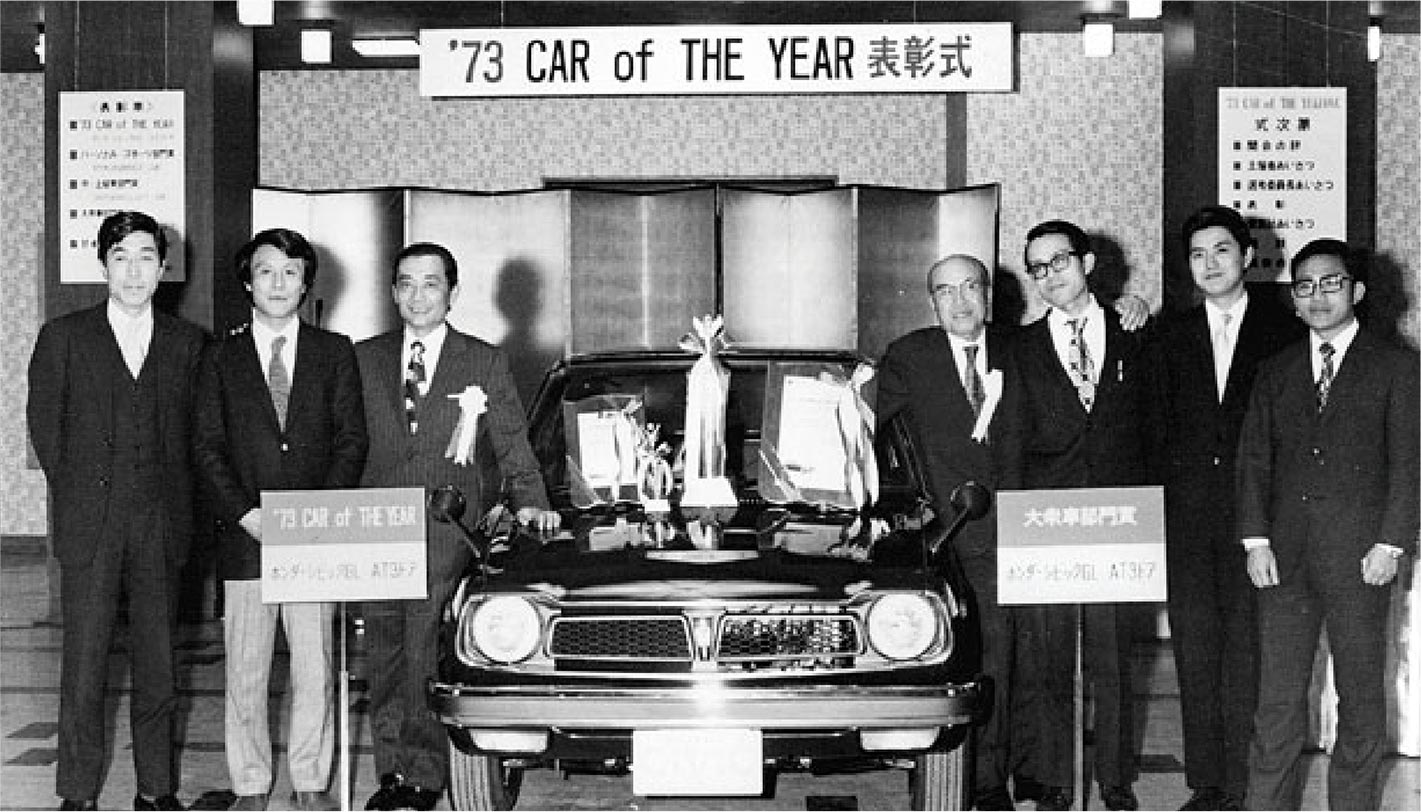
The Civic was the first car in history to win first place in the Car of the Year and Popular Car categories sponsored by Motor Fan magazine for three consecutive years (1972 to 1974).
Evolving Into the World Standard Car
The Civic was receiving exceptionally high marks outside Japan as well. In Europe, the Civic ranked third in the European Car of the Year awards – the highest ranking for a Japanese vehicle at that time. In the U.S., Civic was named Road Test magazine’s Car of the Year in 1974. And in Canada, Civic was the best-selling import car for 28 consecutive months between 1976 and 1978.
What solidified Civic’s high reputation outside Japan was the fact that the Civic equipped with the Honda CVCC engine became the world’s first car certified by the U.S. EPA to meet the U.S. Clean Air Act of 1970’s stringent 1975 emissions requirements. Moreover, Civic CVCC’s compatibility with both leaded and unleaded fuels and its excellent fuel economy made a great deal of sense to U.S. consumers.
The U.S. automobile market at that time was in the process of shifting from leaded to unleaded gasoline as one way to address environmental issues. Inevitably, virtually all new models introduced by other automakers were designed exclusively for the use of unleaded fuel. Such new models were equipped with a catalytic converter, thus they could not run on leaded gasoline, because exhaust gas containing lead forms a film on the surface of the catalyst. Despite such trends, due to the impact of the 1973 oil crisis, unleaded gasoline was not yet widely available in the U.S., and consumers who drove cars designed exclusively for the use of unleaded gasoline were forced to wait in long lines at the few gas stations that sold it.
The CVCC engine realized cleaner exhaust through combustion in an engine equipped with a prechamber, thus it did not need/have a catalytic converter. In other words, Civic CVCC ran on either leaded or unleaded fuel. Yoshihide Munekuni, who at that time was working in the automobile sales operations of American Honda Motor, explained: “The catchphrase we used for the Civic CVCC promotional campaign was ‘Any Kind of Gas’, and this campaign conveyed a positive image of Honda as a company with outstanding technological capability. The Civic liberated customers from the drudgery of waiting in long lines at gas stations.”
As for fuel economy, in addition to the adoption of the CVCC engine, comprehensive weight reduction contributed to the excellent fuel economy of Civic, making it no.1 in the U.S. EPA’s very first list of the top ten vehicles for fuel economy in the U.S. and for four consecutive years starting in 1974.
Developed with an eye toward success as a world-class car, the Japan-made Civic received high praise from automotive journalists the world over, turning the difficulty of addressing environmental issues and the oil crisis into an opportunity and, more than anything, won tremendous support from customers, which enabled it to achieve a great leap forward to literally become the world standard car.
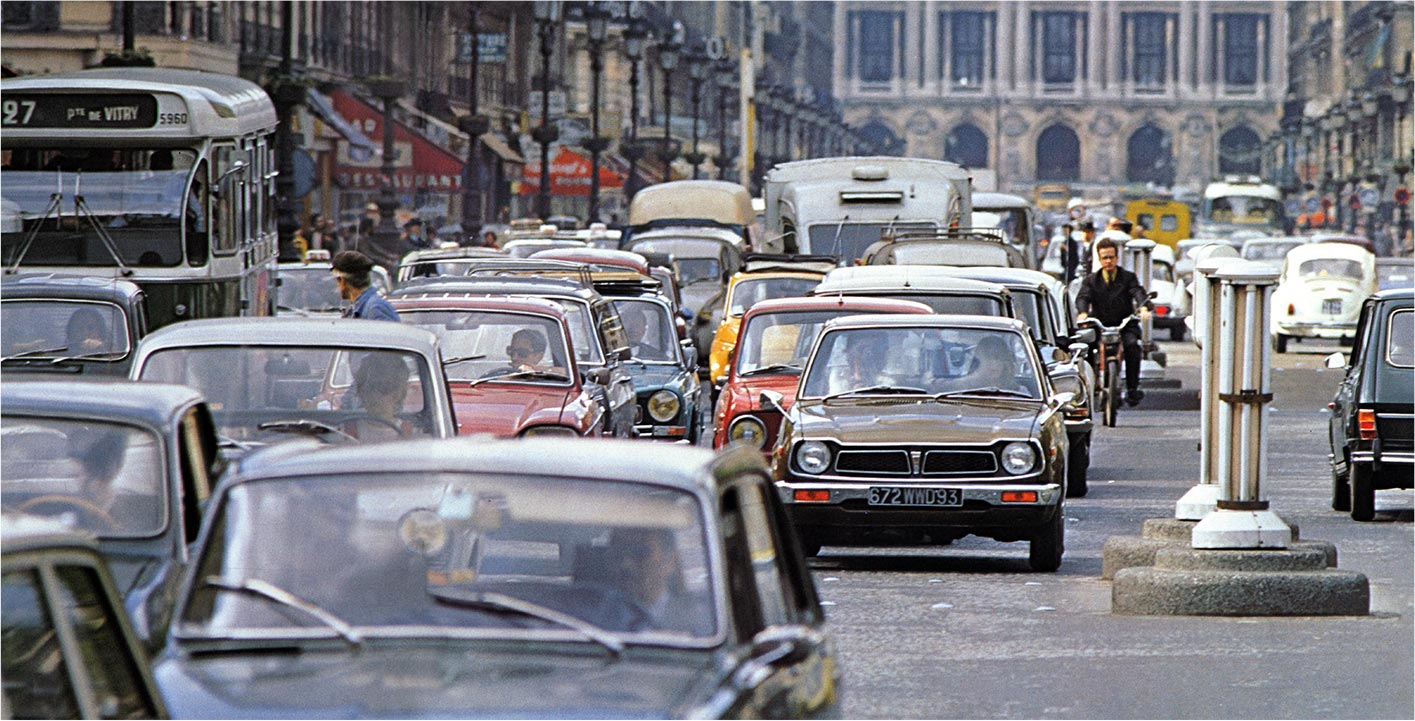
The Civic was developed with the aim of becoming “a car for the global market.” The Civic was the first Japanese car to win the Car of the Year award in Europe, and was highly acclaimed around the world, becoming the world’s standard car.
The People’s Car
In 2022, the Honda Civic celebrated its 50th anniversary. Civic has changed to accommodate the needs of the times and, from the 8th generation (2005) onward, the body size increased and exceeded the size limits of the “5-series” small car class*4 of the Japanese automobile classification. Despite such changes, the Civic’s true identity has never wavered.
More so than any other car, Civic stands as Honda’s wholehearted response to the question, “What kind of car is really needed today?” This is the main reason why Civic has won the love and admiration of people across many countries and over these many years.
About 50 years ago, shortly before the market launch of the new model being developed under the code name “634”, Iwakura received a phone call from Kiyohiko Okumoto, then head of Honda’s sales promotion division. “We’ve thought up a name for the new car. But, since you know this car more than anyone else, I’d really like to hear if you like the name.” continued Okamoto. “The name is ‘Civic.’" The moment Iwakura heard the name, he shivered with emotion. It was as if the name was a distillation of the beliefs and passions shared by all engineers who’d worked on this new vehicle.
The naming of this new model demonstrated that the passion of the project team had become imbued within Honda. So, it was not surprising that both Kizawa and Iwakura said almost exactly the same thing when they were asked to look back on the development of the Civic: “We must have the courage of our conviction about what kind of car we want to create while visualizing the smiles our customers would have on their faces while driving our car. Without trying to convey the thoughts and passion we put in, we will never be able to deliver good products to our customers. With Civic, we were able to fully pursue such an approach.”
- The 5-series category: Vehicles which fulfill each of the following size limits: Total length of 4,700 mm or less, width of 1,700 mm or less and height of 2,000 mm or less, engine size of 2,000 cc or less.
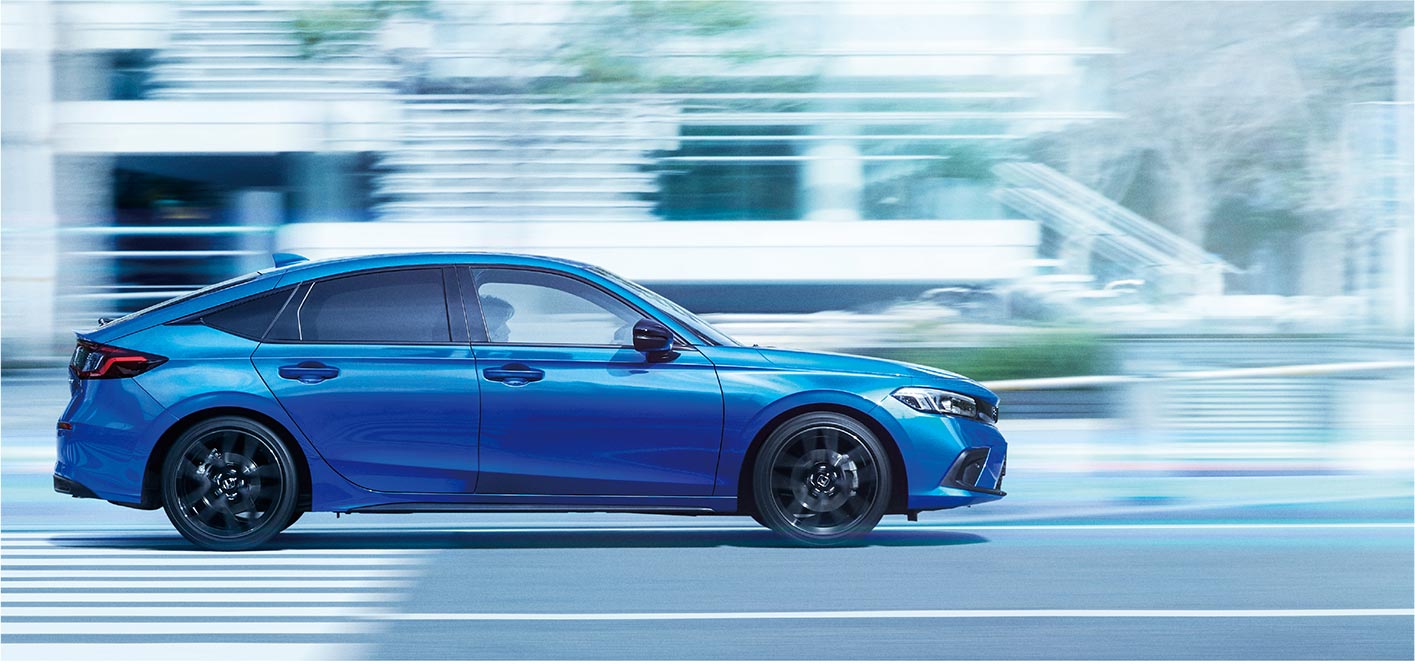
The Civic celebrated its 50th anniversary in 2022. While changing with the times, the Civic continues to pursue the proposition of “what is a genuinely necessary in a car today.”
